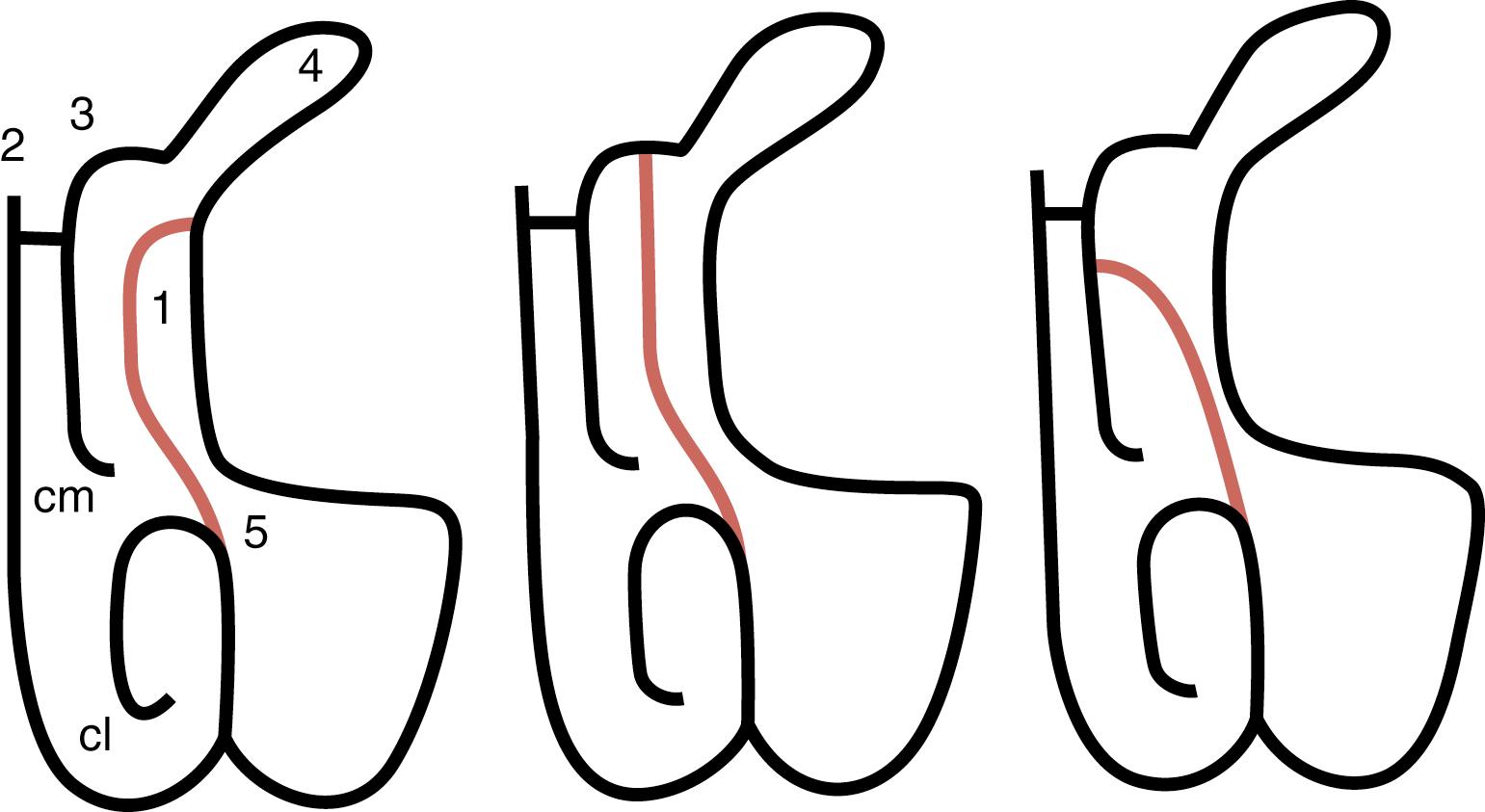Physical Address
304 North Cardinal St.
Dorchester Center, MA 02124
The endoscopic approach to the frontal sinus is predicated on understanding the anatomy of the frontal recess. The frontal sinus outflow tract is dependent on the anatomic relationships of various structures, including the uncinate process, middle turbinate, agger nasi, and frontoethmoid cells. Most commonly, the uncinate process ascends from its inferior and anterior attachments to the inferior turbinate and lacrimal bone, respectively, to blend in with the medial wall of the agger nasi cell ( Fig. 112.1 ). In such cases—85% of the time—the frontal sinus will drain between the uncinate process and the middle turbinate. In the remaining cases, the uncinate attaches to the middle turbinate or the skull base, resulting in the frontal sinus draining directly into the infundibulum. If the uncinate attaches both medially to the middle turbinate and laterally to the agger nasi, the frontal sinus will drain posteriorly.

Excellent understanding of frontal sinus anatomy is imperative to achieve optimal surgical outcomes.
Preoperative preparation with review of computed tomography (CT) scan anatomy using imaging software capable of three-dimensional multiplanar reconstructions similar to the software incorporated by image guidance systems is strongly encouraged.
Proper exposure and visualization are fundamental to good frontal sinus surgery.
History of present illness
Patients with chronic frontal sinus disease are considered surgical candidates according to the same criteria as for other endoscopic sinus surgery. They should have significant symptoms of sinusitis in accordance to the criteria proposed by the American Academy of Otolaryngology–Head and Neck Surgery despite maximal medical therapy.
Those with isolated or severe forehead/frontal pain relative to other symptoms should be counseled that their main complaint may not improve with endoscopic sinus surgery even when imaging reveals frontal disease.
Past medical history
Relevant comorbidities include the presence or absence of aspirin sensitivity, asthma, atopy, and eosinophilia.
New or continued frontal sinus problems despite prior history of sinus surgery may suggest chronic inflammatory disease of the sinonasal mucosa or scarring of the frontal recess such as from synechiae between the middle turbinate and the lateral nasal wall or between the middle turbinate and the anterior face of a suprabullar cell.
Nasal cavity
Nasal endoscopy may reveal significant inflammation in the middle meatus such as from nasal polyps. Patients who have previously undergone sinus surgery may have visible scarring in the frontal recess or anterior ethmoid cells. The location and quality of secretions should be noted.
Face
Although thankfully rare, complications from frontal sinusitis may present with abnormal findings on physical examination. Orbital complications may present as proptosis or orbital cellulitis. Visible, palpable swelling of the forehead may suggest osteomyelitis and subperiosteal abscess of the anterior table (Pott’s puffy tumor).
CT scan of the sinuses
All patients undergoing frontal sinus surgery should have a CT scan of the sinuses performed. Modern radiation dose-reducing CT scanners, which reduce radiation exposure by up to 40%, may be used to obtain fine-cut images (0.6 to 1.0 mm) through the sinuses that are adequate for creating multiplanar reconstructions for preoperative planning, as well as intraoperative image guidance with negligible increase in overall radiation dosage. Most frequently, fine-cut axial images are used to reconstruct coronal and sagittal images for image guidance, but some systems have the ability to reconstruct from coronal slices as well. Preoperatively, review of images in both the coronal and sagittal planes may be useful. When intraoperative image guidance is considered, we strongly encourage preparation with the use of imaging software capable of multiplanar reconstruction, often abbreviated as MPR, which allows the surgeon to review all three planes simultaneously with crosshairs in each plane much like what is provided during surgery.
Radiographs should be reviewed carefully before surgery to evaluate the uncinate process, agger nasi region, and the size and depth of the frontal sinus. The most important aspect of surgical planning is accurate understanding of the three-dimensional impact of the size and configuration of all cells surrounding the frontal recess. Images should be reviewed to note the position of the anterior ethmoid artery and the presence or absence of supraorbital ethmoid cells. Patients should be suspected of having supraorbital ethmoid cells if multiple septations are seen within the frontal sinus on coronal images. Preoperative three-dimensional models may also be created to further understand the frontal sinus drainage pathway in preparation for surgery.
Magnetic resonance imaging (MRI)
Although MRI is not routine, it may be helpful in patients with known or suspected tumors or mucoceles involving the frontal sinuses.
Chronic frontal sinusitis refractory to maximal medical therapy, including the following:
Eosinophilic or noneosinophilic inflammatory chronic rhinosinusitis with or without nasal polyposis
Mechanical obstruction
Anatomic variants of frontal recess structures
Osteomas
Frontal sinus mucoceles
Acute frontal sinusitis with
Severe disease refractory to medical management (i.e., intravenous antibiotics)
Intracranial or orbital complications
Limited tumors involving the frontal sinus that do not require an open procedure
Uncomplicated acute frontal sinusitis
Extensive tumors involving the frontal sinus that may benefit from open surgery
Medical comorbidities with increased risk for general anesthesia
Inadequate surgical instrumentation or surgeon expertise
Acute frontal sinusitis is not usually a good indication for endoscopic frontal sinus surgery. These patients have significant hyperemia and inflammation, and there is a high likelihood of creating symptomatic scarring in the frontal recess. If there are intracranial or orbital complications from acute frontal sinusitis that are refractory to intravenous antibiotics, the decision to intervene surgically via a classic frontal sinus trephination versus an endoscopic approach may be considered on a case-by-case basis.
Discontinue antiplatelet drugs.
Systemic steroids and/or antibiotics may be used to decrease vascularity and edema in the frontal recess. Given the limited confines of the frontal recess, bleeding and the resultant decreased visibility may compromise the surgical dissection.
Become a Clinical Tree membership for Full access and enjoy Unlimited articles
If you are a member. Log in here